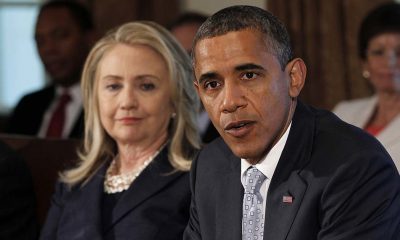Feature
Nine Indian students win awards at prestigious international science, engineering fair

New York: An Indian American student won the prestigious Intel Foundation Young Scientist Award Friday, while nine students from across India won awards in various categories and five US students were awarded science trips to India at the Intel International Science and Engineering Fair (IISEF) in Pttsburgh.
The IISEF honors the world’s most promising high school student scientists, inventors and engineers selected through rigorous competitions held around the world. Many past winners have gone on to win Nobel Prizes and other prestigious awards.
For his work on refining a system to help protect the seas from oil-drilling disasters, Karan Jerath, 18, of Friendswood, Texas, received the $50,000 Young Scientist Award, the second highest prize at the IISEF.
Jerath was also one of the five students selected for the Intel and Indo-US Science and Technology Forum Visit to India Award. They will receive a weeklong visit to India to showcase their research projects, visit research leading institutions and interact with top scientists.
Onkar Singh Gujral, 18, of La Martiniere for Boys in Kolkata, won the Association of Computing Machinery first award and the second award in the System software category for his entry on image processing algorithms for detecting nanomaterials.
The other Indian winners came from Delhi, Kozhikode, Mangalore and Panipat.
An Indian American foundation, gave ten awards at the Fair. Sanjana J. Rane, 17, of Louisville, Kentucky, received the first award for work relating to renal fibrosis from the Ashtavadhani Vidwan Ambati Subbaraya Chetty Foundation based in Georgia. Five American students of Indian descent were among those who received the foundations second awards.
About 1,700 students who participated at the IISEF in Pittsburgh were the top performers at 422 affiliated fairs held in 75 countries. At the IISEF their projects went through rigorous evaluations by about 1,000 judges with PhDs or equivalent qualifications from across scientific disciplines.
Seventeen students from India were selected for the IISEF from the National Science Fair held by Initiative for Research and Innovation in Science.
Maya Ajmera, who is Indian descent and heads the Society for Science and the Public that conducts the IISEF, congratulated the winners and said, “These talented young students are the problem solvers and innovators of their generation.”
The top prize, the $75,000 Gordon E. Moore Award, went to Raymond Wang, 17, of Canada.
Scores of Indian American students won awards in various categories, five of them getting the first award in their specialisations, biochemistry, behavioral sciences, environmental engineering, mathematics and energy physics.
More than 200 Indian American students were among the finalists at the IISEF, having won regional competitions across the US. In addition, students of Indian descent came from South Africa, Malaysia and Singapore.
These are the other winners from schools in India:
* Mansi Aggarwal, 17, and Harshit Jindal, 14, of Maharaja Agarsain Public School, Delhi: Fourth Award in Plant Sciences category for research on “An Effective Herbal Ointment against Enterobiasis”
* Ravi Pradip, 17, of Dayapuram Residential School, Kozhikode, Kerala: Third Place in Material Sciences for work on “Plumeria Blooms for Organic Electronics”
* Arsh Shah Dilbagi, 17, of DAV Public School, Panipat, Haryana, Third Award in Embedded Systems category for developing “TALK-An AAC Device: Converting Breath into Speech for the Disabled”
* Mansi Aggarwal, 17, and Harshit Jindal, 14, of Maharaja Agarsain Public School, Delhi: Fourth Award in Plant Sciences category for research on “An Effective Herbal Ointment against Enterobiasis”
* Aditya Bhargava, 16, and Komal S, 16, of Sharada Vidyanikethana Public School, Mangalore, Karnataka: Fourth Award in Material Sciences for work on “Highly Sensitive Nano-Ferrite for Detection of Carbon Monoxide in Air”
Entertainment
Meghalaya Reserves Legalized Gambling and Sports Betting for Tourists

The State Scores Extra High on Gaming-Friendly Industry Index
Meghalaya scored 92.85 out of 100 possible points in a Gaming Industry Index and proved to be India’s most gaming-friendly state following its recent profound legislation changes over the field allowing land-based and online gaming, including games of chance, under a licensing regime.
The index by the UK India Business Council (UKIBC) uses a scale of 0 to 100 to measure the level of legalisation on gambling and betting achieved by a state based on the scores over a set of seven different games – lottery, horse racing, betting on sports, poker, rummy, casino and fantasy sports
Starting from February last year, Meghalaya became the third state in India’s northeast to legalise gambling and betting after Sikkim and Nagaland. After consultations with the UKIBC, the state proceeded with the adoption of the Meghalaya Regulation of Gaming Act, 2021 and the nullification of the Meghalaya Prevention of Gambling Act, 1970. Subsequently in December, the Meghalaya Regulation of Gaming Rules, 2021 were notified and came into force.
All for the Tourists
The move to legalise and license various forms of offline and online betting and gambling in Meghalaya is aimed at boosting tourism and creating jobs, and altogether raising taxation revenues for the northeastern state. At the same time, the opportunities to bet and gamble legally will be reserved only for tourists and visitors.
“We came out with a Gaming Act and subsequently framed the Regulation of Gaming Rules, 2021. The government will accordingly issue licenses to operate games of skill and chance, both online and offline,” said James P. K. Sangma, Meghalaya State Law and Taxation Minister speaking in the capital city of Shillong. “But the legalized gambling and gaming will only be for tourists and not residents of Meghalaya,” he continued.
To be allowed to play, tourists and people visiting the state for work or business purposes will have to prove their non-resident status by presenting appropriate documents, in a process similar to a bank KYC (Know Your Customer) procedure.
Meghalaya Reaches Out to a Vast Market
With 140 millions of people in India estimated to bet regularly on sports, and a total of 370 million desi bettors around prominent sporting events, as per data from one of the latest reports by Esse N Videri, Meghalaya is set to reach out and take a piece of a vast market.
Estimates on the financial value of India’s sports betting market, combined across all types of offline channels and online sports and cricket predictions and betting platforms, speak about amounts between $130 and $150 billion (roughly between ₹9.7 and ₹11.5 lakh crore).
Andhra Pradesh, Telangana and Delhi are shown to deliver the highest number of bettors and Meghalaya can count on substantial tourists flow from their betting circles. The sports betting communities of Karnataka, Maharashtra, Uttar Pradesh and Haryana are also not to be underestimated.
Among the sports, cricket is most popular, registering 68 percent of the total bet count analyzed by Esse N Videri. Football takes second position with 11 percent of the bets, followed by betting on FIFA at 7 percent and on eCricket at 5 percent. The last position in the Top 5 of popular sports for betting in India is taken by tennis with 3 percent of the bet count.
Local Citizens will Still have Their Teer Betting
Meghalaya residents will still be permitted to participate in teer betting over arrow-shooting results. Teer is a traditional method of gambling, somewhat similar to a lottery draw, and held under the rules of the Meghalaya Regulation of the Game of Arrow Shooting and the Sale of Teer Tickets Act, 2018.
Teer includes bettors wagering on the number of arrows that reach the target which is placed about 50 meters away from a team of 20 archers positioned in a semicircle.
The archers shoot volleys of arrows at the target for ten minutes, and players place their bets choosing a number between 0 and 99 trying to guess the last two digits of the number of arrows that successfully pierce the target.
If, for example, the number of hits is 256, anyone who has bet on 56 wins an amount eight times bigger than their wager.























